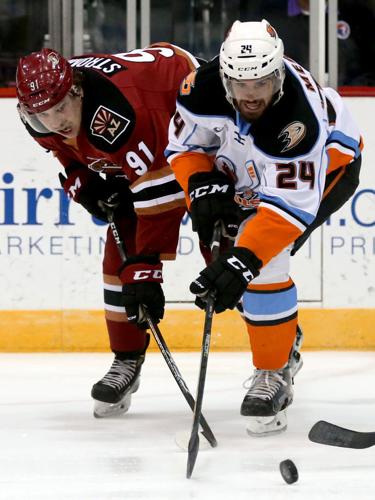Championship moments last forever for a sports franchise, even if the team itself fades away.
I still remember the overwhelming pride I felt when my hometown WHA Indianapolis Racers raised a banner to the arena rafters. That was way back in 1976, and that team is long gone.
Now the Tucson Roadrunners are AHL Western Conference champions. The moment is a benchmark in our hockey history.
There’s no time for backslapping, though. The most important part of this season, the playoffs, begins in a few days. It is the perfect time to look back on “The Good, The Bad, and The Ugly” from the Tucson Roadrunners’ 2017-18 campaign.
The good
“The Good” is easy to describe on this championship hockey team. The Roadrunners improved in almost all categories over their inaugural run: more timely goals, stronger defense and steadier goaltending. They show a concerted team grit and cohesiveness, in contrast to last year’s squad that crashed and burned over the second half.
The maestro for this improvement is head coach Mike Van Ryn, a decidedly more salty, feisty and vocal leader than predecessor Mark Lamb.
Where Lamb led with a gentler coaching style, Van Ryn’s in-your-face personality seemed to electrify this year’s lineup. I have long believed that coaching in the AHL is perhaps the most difficult in all of pro hockey. You never know who will be in your lineup from day to day, and the up-and-down player swaps with the parent NHL club can be unrelenting.
Then there are players who gripe that they should have gotten the call-up instead of a teammate, and players who have not developed as quickly as they would like. (Often these are the same players.) It does not take much of that to upset the balance in an AHL locker room.
Van Ryn has been able to galvanize this year’s squad by getting them to buy into the ultimate AHL carrot: If the Roadrunners win, the Coyotes will take notice.
It has worked. Tucson was in first place in their division for most of the season, and their consistent play defied the way-up and way-down lurches that plague many AHL teams. We might soon need to add “AHL Coach Of The Year” next to Mike Van Ryn’s divisional championship status.
The bad
Injuries hurt the Roadrunners as much, if not worse, than any other AHL team. Tucson will not have two of its most important cogs for the playoffs, center Laurent Dauphin and winger Nick Merkley. A trade with Cleveland brought veteran Carter Camper to the fold, however, adding instant scoring punch.
The Coyotes also sent four key players to Tucson at the conclusion of the NHL season. Rookie sensation Dylan Strome is the Roadrunners’ dynamic X-factor at center, but the three defensemen sent back are just as important. You win tight playoff rounds at the blue line, and Trevor Murphy, Joel Hanley, and Dakota Mermis give Tucson instant defensive depth and experience.
These roster additions also put a spotlight on the curious sophomore season for big blueliner Kyle Wood. Wood was an AHL All-Star in his rookie season, but his development this season has been slow. Wood subsequently has been a healthy scratch for several games, and his shot from the point has not been as open as before. I am eager to see how much ice time Wood, a Tucson fan-favorite, sees in this playoff year.
I also wondered about rookie goaltender Hunter Miska after a rocky season-opener, but his professional presence has developed rapidly. Second-year Roadrunner Adin Hill eventually emerged as the team’s No. 1 back stopper just in time for the playoff run. I love how defiantly Hill throws the puck back out to the face-off circle after making a big save. The Roadrunners will go as deep as Hill takes them.
Another challenge for this squad is the last-place-NHL parent Coyotes’ great need for immediate talent. It is an imprecise art for coaches and general managers to know when a young player is ready to arrive and stay in the NHL. That art gets fuzzier and fuzzier when you are a struggling major-league team with some tantalizing young talent in Tucson. The Coyotes have drafted well in recent years, and they need that young talent in Glendale, and fast.
That means for every former Roadrunner like Brendan Perlini, who proved last year that he was ready for the bigs, there have been several more who have perhaps been rushed upstairs for looks. Sure, the days of spending several full years in the minors to prepare for the NHL are certainly over for most, but there are some Roadrunners who will benefit the Coyotes more, in the end, if they spend a longer time in the Old Pueblo.
Strome, for instance, has been a stunning offensive killer here in Tucson, but his sporadic time in Glendale had not been nearly as productive — until the end of this season when he caught fire for the Coyotes. Patience and some heavy AHL playoff time back in Tucson will now serve Strome well.
The ugly
“The ugly” for any AHL team — and there is not much in the negative column when analyzing the Roadrunners’ current season — has to do with the inevitable nature of minor league hockey organizations. While the Roadrunners franchise is stocked with talented professionals on and off the ice, the truth is that very few in this organization want to stay in Tucson.
Minor-league markets like Tucson are a waiting room for most players and staff who wish they were in the major leagues. Very few in the Roadrunners organization are longtime Tucsonans, and most do not plan to be here very long.
The AHL playoffs now give in the Roadrunners organization the chance to shine on a larger stage. They also offer the franchise a bonus period to get ahead in the financial column. Those extra games, with most likely the largest crowds of the year, can be a financial and market awareness boost.
The Roadrunners were averaging 4,160 fans per home game this season heading into Saturday’s home finale, an improvement of 106 fans per game over last year. Team president Bob Hoffman said he’s pleased with the modest gain, noting that attendance for many new teams actually slips in their second year.
Tucson’s attendance ranks just 22nd out of the 30 teams in the AHL, but Hoffman said comparisons to other markets cannot accurately reflect the young Tucson team’s financial situation. Coyotes officials are reportedly pleased with Tucson’s progress, corporate sales have improved and that the Roadrunners are doing just fine in the ledger books.
Back on the ice, the team’s win percentage is far superior away from home, oddly enough. It is little surprise that the Roadrunners chose to start the playoffs on the road, where they have been dominant. Now we will wait and see if a true playoff home ice advantage blossoms for Tucson along with the Arizona spring.
A string of big playoff wins at home is one of the few things left on the AHL Western Conference champions’ checklist in a season of so much Roadrunner good and so little bad and ugly.






